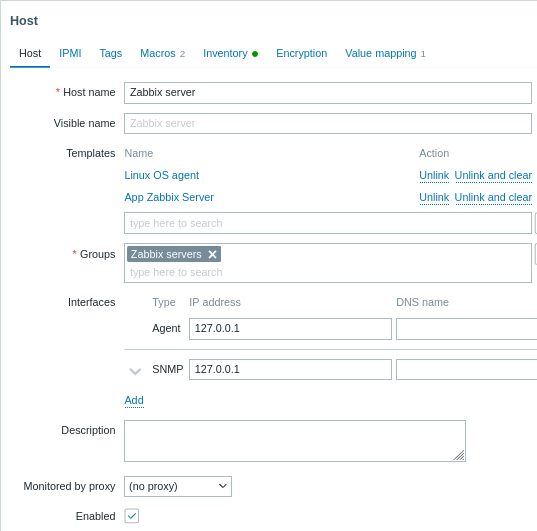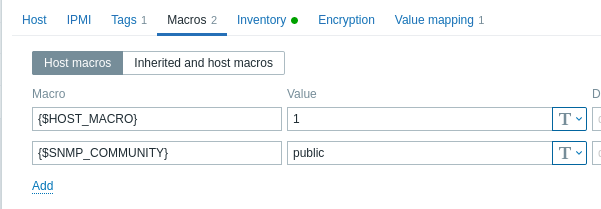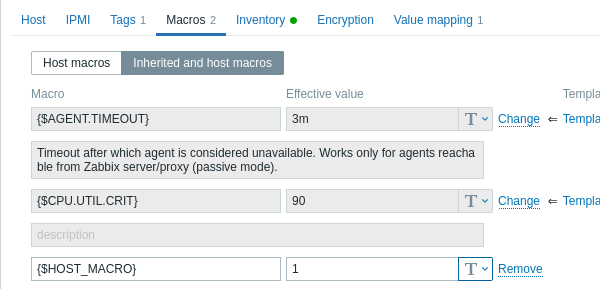6.0
This is a translation of the original English documentation page. Help us make it better.
Table of Contents
1 Gazda konfigurálása
Áttekintés
Egy gazdagép konfigurálásához a Zabbix frontendben tegye a következőket:
- Nyissa meg: Konfiguráció → Gazdagépek vagy Monitoring → Gazdagépek
- Kattintson a jobb oldalon található Hoszt létrehozása lehetőségre (vagy a gazdagép nevére a szerkesztéshez meglévő gazdagép)
- Adja meg a gazdagép paramétereit az űrlapon
A Klónozás és a Teljes klónozás gombokat is használhatja an meglévő gazdagépet új gazdagép létrehozásához. A Klón gombra kattintva az összes megmarad gazdagépparaméterek és sablonhivatkozások (az összes entitás megtartása ezekből sablonok). A Teljes klón emellett közvetlenül csatolva marad entitások (alkalmazások, elemek, triggerek, grafikonok, alacsony szintű felfedezés szabályok és webes forgatókönyvek).
Megjegyzés: Amikor egy gazdagépet klónoznak, az összes sablon entitást megtartja eredetileg a sablonon vannak. Az entitásokon végrehajtott bármilyen változtatás a meglévő gazdagép szintjén (például megváltozott tételintervallum, módosított reguláris kifejezés vagy hozzáadott prototípusok az alacsony szintű felfedezési szabályhoz) nem klónozzák az új gazdagépre; ehelyett olyanok lesznek, mint a sablon.
Configuration
The Host tab contains general host attributes:

All mandatory input fields are marked with a red asterisk.
| Parameter | Description | |
|---|---|---|
| Host name | Enter a unique host name. Alphanumerics, spaces, dots, dashes and underscores are allowed. However, leading and trailing spaces are disallowed. Note: With Zabbix agent running on the host you are configuring, the agent configuration file parameter Hostname must have the same value as the host name entered here. The name in the parameter is needed in the processing of active checks. |
|
| Visible name | Enter a unique visible name for the host. If you set this name, it will be the one visible in lists, maps, etc instead of the technical host name. This attribute has UTF-8 support. | |
| Templates | Link templates to the host. All entities (items, triggers, graphs, etc) will be inherited from the template. To link a new template, start typing the template name in the Link new templates field. A list of matching templates will appear; scroll down to select. Alternatively, you may click on Select next to the field and select templates from the list in a popup window. The templates that are selected in the Link new templates field will be linked to the host when the host configuration form is saved or updated. To unlink a template, use one of the two options in the Linked templates block: Unlink - unlink the template, but preserve its items, triggers and graphs Unlink and clear - unlink the template and remove all its items, triggers and graphs Listed template names are clickable links leading to the template configuration form. |
|
| Groups | Select host groups the host belongs to. A host must belong to at least one host group. A new group can be created and linked to the host group by adding a non-existing group name. | |
| Interfaces | Several host interface types are supported for a host: Agent, SNMP, JMX and IPMI. No interfaces are defined by default. To add a new interface, click on Add in the Interfaces block, select the interface type and enter IP/DNS, Connect to and Port info. Note: Interfaces that are used in any items cannot be removed and link Remove is grayed out for them. See Configuring SNMP monitoring for additional details on configuring an SNMP interface (v1, v2 and v3). |
|
| IP address | Host IP address (optional). | |
| DNS name | Host DNS name (optional). | |
| Connect to | Clicking the respective button will tell Zabbix server what to use to retrieve data from agents: IP - Connect to the host IP address (recommended) DNS - Connect to the host DNS name |
|
| Port | TCP/UDP port number. Default values are: 10050 for Zabbix agent, 161 for SNMP agent, 12345 for JMX and 623 for IPMI. | |
| Default | Check the radio button to set the default interface. | |
| Description | Enter the host description. | |
| Monitored by proxy | The host can be monitored either by Zabbix server or one of Zabbix proxies: (no proxy) - host is monitored by Zabbix server Proxy name - host is monitored by Zabbix proxy "Proxy name" |
|
| Enabled | Mark the checkbox to make the host active, ready to be monitored. If unchecked, the host is not active, thus not monitored. | |
The IPMI tab contains IPMI management attributes.
| Parameter | Description |
|---|---|
| Authentication algorithm | Select the authentication algorithm. |
| Privilege level | Select the privilege level. |
| Username | User name for authentication. User macros may be used. |
| Password | Password for authentication. User macros may be used. |
The Tags tab allows you to define host-level tags. All problems of this host will be tagged with the values entered here.

User macros, {INVENTORY.*} macros, {HOST.HOST}, {HOST.NAME}, {HOST.CONN}, {HOST.DNS}, {HOST.IP}, {HOST.PORT} and {HOST.ID} macros are supported in tags.
The Macros tab allows you to define host-level user macros as a name-value pairs. Note that macro values can be kept as plain text, secret text or Vault secret. Adding a description is also supported.

You may also view here template-level and global user macros if you select the Inherited and host macros option. That is where all defined user macros for the host are displayed with the value they resolve to as well as their origin.

For convenience, links to respective templates and global macro configuration are provided. It is also possible to edit a template/global macro on the host level, effectively creating a copy of the macro on the host.
The Host inventory tab allows you to manually enter inventory information for the host. You can also select to enable Automatic inventory population, or disable inventory population for this host.

If inventory is enabled (manual or automatic), a green dot is displayed with the tab name.
Encryption
The Encryption tab allows you to require encrypted connections with the host.
| Parameter | Description |
|---|---|
| Connections to host | How Zabbix server or proxy connects to Zabbix agent on a host: no encryption (default), using PSK (pre-shared key) or certificate. |
| Connections from host | Select what type of connections are allowed from the host (i.e. from Zabbix agent and Zabbix sender). Several connection types can be selected at the same time (useful for testing and switching to other connection type). Default is "No encryption". |
| Issuer | Allowed issuer of certificate. Certificate is first validated with CA (certificate authority). If it is valid, signed by the CA, then the Issuer field can be used to further restrict allowed CA. This field is intended to be used if your Zabbix installation uses certificates from multiple CAs. If this field is empty then any CA is accepted. |
| Subject | Allowed subject of certificate. Certificate is first validated with CA. If it is valid, signed by the CA, then the Subject field can be used to allow only one value of Subject string. If this field is empty then any valid certificate signed by the configured CA is accepted. |
| PSK identity | Pre-shared key identity string. Do not put sensitive information in the PSK identity, it is transmitted unencrypted over the network to inform a receiver which PSK to use. |
| PSK | Pre-shared key (hex-string). Maximum length: 512 hex-digits (256-byte PSK) if Zabbix uses GnuTLS or OpenSSL library, 64 hex-digits (32-byte PSK) if Zabbix uses mbed TLS (PolarSSL) library. Example: 1f87b595725ac58dd977beef14b97461a7c1045b9a1c963065002c5473194952 |
Értékleképezés
Az Értékleképezés lap lehetővé teszi az emberbarát beállítást cikkadatok megjelenítése a érték leképezések.
To toggle search highlight, press Ctrl+Alt+H
Have an improvement suggestion for this page? Select the text that could be improved and press Ctrl+Enter to send it to the editors.
© 2001-2025 by Zabbix SIA. All rights reserved.
Except where otherwise noted, Zabbix Documentation is licensed under the following license
